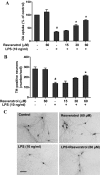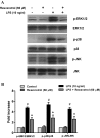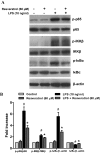Resveratrol protects dopamine neurons against lipopolysaccharide-induced neurotoxicity through its anti-inflammatory actions
- PMID: 20554604
- PMCID: PMC2939485
- DOI: 10.1124/mol.110.064535
Resveratrol protects dopamine neurons against lipopolysaccharide-induced neurotoxicity through its anti-inflammatory actions
Erratum in
- Mol Pharmacol. 2010 Nov;78(5):981
Abstract
Parkinson's disease (PD) is the second most common neurodegenerative disease characterized by a progressive loss of dopamine (DA) neurons in the substantia nigra. Accumulating evidence indicates that inhibition of microglia-mediated neuroinflammation may become a reliable protective strategy for PD. Resveratrol, a nonflavonoid polyphenol naturally found in red wine and grapes, has been known to possess antioxidant, anticancer, and anti-inflammatory properties. Although recent studies have shown that resveratrol provided neuroprotective effects against ischemia, seizure, and neurodegenerative disorders, the mechanisms underlying its beneficial effects on dopaminergic neurodegeneration are poorly defined. In this study, rat primary midbrain neuron-glia cultures were used to elucidate the molecular mechanisms underlying resveratrol-mediated neuroprotection. The results clearly demonstrated that resveratrol protected DA neurons against lipopolysaccharide (LPS)-induced neurotoxicity in concentration- and time-dependent manners through the inhibition of microglial activation and the subsequent reduction of proinflammatory factor release. Mechanistically, resveratrol-mediated neuroprotection was attributed to the inhibition of NADPH oxidase. This conclusion is supported by the following observations. First, resveratrol reduced NADPH oxidase-mediated generation of reactive oxygen species. Second, LPS-induced translocation of NADPH oxidase cytosolic subunit p47 to the cell membrane was significantly attenuated by resveratrol. Third and most importantly, resveratrol failed to exhibit neuroprotection in cultures from NADPH oxidase-deficient mice. Furthermore, this neuroprotection was also related to an attenuation of the activation of mitogen-activated protein kinases and nuclear factor-kappaB signaling pathways in microglia. These findings suggest that resveratrol exerts neuroprotection against LPS-induced dopaminergic neurodegeneration, and NADPH oxidase may be a major player in resveratrol-mediated neuroprotection.
Figures








References
-
- Akira S, Takeda K, Kaisho T. (2001) Toll-like receptors: critical proteins linking innate and acquired immunity. Nat Immunol 2:675–680 - PubMed
-
- Bhat NR, Zhang P, Lee JC, Hogan EL. (1998) Extracellular signal-regulated kinase and p38 subgroups of mitogen-activated protein kinases regulate inducible nitric oxide synthase and tumor necrosis factor-alpha gene expression in endotoxin-stimulated primary glial cultures. J Neurosci 18:1633–1641 - PMC - PubMed
-
- Bi XL, Yang JY, Dong YX, Wang JM, Cui YH, Ikeshima T, Zhao YQ, Wu CF. (2005) Resveratrol inhibits nitric oxide and TNF-alpha production by lipopolysaccharide-activated microglia. Int Immunopharmacol 5:185–193 - PubMed
Publication types
MeSH terms
Substances
Grants and funding
LinkOut - more resources
Full Text Sources
Other Literature Sources

